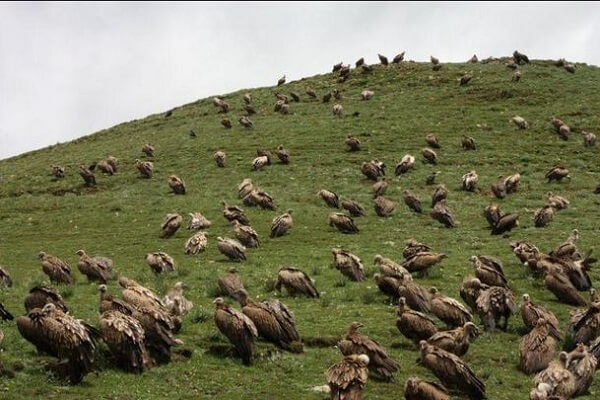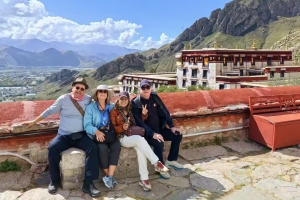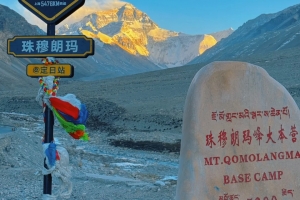When visiting Tibet, you may encounter a unique funeral tradition known as sky burial. This practice is deeply rooted in the region’s culture and spirituality and holds significant meaning for the local people. In Tibetan Buddhism, sky burial symbolizes liberating the soul from the body after death. This overview will explain sky burial and how the Tibetan community performs this traditional ritual.
Reason of Sky Burial
Sky burial, a traditional funerary practice integral to Tibetan Buddhism, is not just a ritual, but a profound expression of the spiritual beliefs and rich cultural heritage of the Tibetan people. This unique ceremony, deeply rooted in the beliefs surrounding death and the afterlife, underscores the intricate relationship between the Tibetan people and their environment.
In Tibetan philosophy, offering one’s body to vultures embodies a profound metaphor for impermanence and the cycle of life and death. It is rooted in the belief that the deceased’s soul can ascend to the heavens by allowing nature to reclaim the physical form. This idea is intertwined with the concept of achieving a favourable rebirth or reaching enlightenment, which resonates powerfully within the spiritual framework of Tibetan Buddhism.

Vultures Dealing with Remains
The practice is often conducted in remote, sacred sites elevated above the valley floors, where high altitudes are believed to help the soul’s journey to the afterlife. When a person passes away, their family typically chooses this method of burial as a final act of compassion, ensuring that their loved one transcends the earthly plane without attachment.
Lamas (Buddhist monks) are essential during the ceremony, offering prayers and chanting sutras to guide and safeguard the spirit in its transition. As vultures gather, their body consumption symbolises the purity of the deceased’s life; it is believed that if the birds devour the remains, it indicates the presence of no sin and that the departed soul will experience a peaceful ascent to Paradise.
Any remains that may be left—bones or other parts unchanged by the vultures—are collected and burned in a subsequent rite. The Lamas also perform this act, chanting continuously to redeem the deceased’s sins and ensure that nothing binds their spirit to the earthly realm. This is a vital part of the process of liberating the soul from attachments, allowing it to move on in its spiritual journey.
Preparation and Mantra Chanting
In Tibetan culture, the passing of a loved one is a communal event. The family wraps the deceased’s body in white cloth and places it in a specific area of the home, where monks or spiritual teachers are invited to read sacred texts aloud. This shared responsibility and the belief that these rituals help the soul move from purgatory create a strong sense of community and support during this difficult time.

Vultures Waiting for the Ritual
Body Dissection for Vultures to Eat
On the chosen day, family members play a crucial role in the burial process. They select a suitable date and ask a body carrier to take the deceased to a special burial site, often called a celestial burial platform. The day before the burial, the family respectfully removes the deceased’s clothing and arranges the body in a curled position, similar to how a fetus rests. This usually means bending the body into a sitting position with the head resting on the knees.
At dawn on the day of the burial, the body is transported to a location in the mountains, away from where people live. To attract condors, a type of bird, a special type of smoke called “Su” is burned. Meanwhile, Lamas (Buddhist priests) chant prayers to help the soul find peace and address wrongdoings. A trained celestial burial master is in charge of taking care of the body throughout this important process.
Taboos of Sky Burial
Celestial funerals hold significant cultural and spiritual importance in Tibet, steeped in deep-rooted traditions and beliefs. Within these ceremonies, it is commonly believed that the presence of strangers can negatively impact the souls of the deceased, potentially hindering their journey to the afterlife. As a result, local customs dictate that visitors and outsiders are kindly asked to refrain from attending these solemn rituals, ensuring that the sanctity of the event is preserved.

Vultures Gathering for the Ritual
Moreover, the practice of sky burial underscores the profound respect for the deceased in Tibetan culture. Family members of the deceased have a specific role to play in this process. They are typically not permitted to be at the burial site during the ceremony, highlighting the belief that the soul’s departure should be a private and sacred occasion, free from the emotional weight that family members might carry. By adhering to these traditions, the community strives to honour the deceased while contributing to a peaceful passage for their spirit.
Overall, sky burial embodies the Tibetan approach to death, one that embraces the natural cycle, emphasizes community, and fosters deep respect for the transcendence of the spirit. This practice highlights the Tibetan people’s unique worldview, where the physical body is seen merely as a temporary vessel, fostering a deep connection to the cosmos and the ongoing flow of life.










